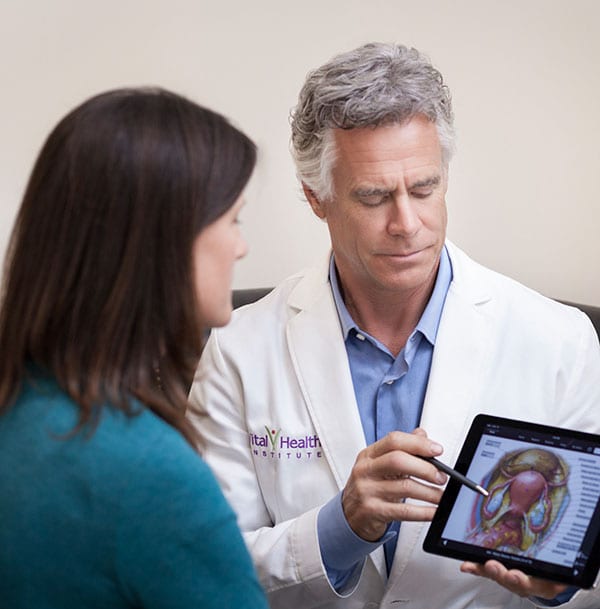Diagnosing Endometriosis
On average, it takes 10 years for a woman to get a diagnosis of endometriosis. Dr. Cook is here to set the record straight. Diagnosing endometriosis is 10 times easier than treating it.
For an endometriosis specialist, it’s not difficult to diagnose endometriosis. There are two tests currently for endo, one is a screening test and the other a diagnostic test. The screening test is like a pap smear and is a relatively inexpensive test. It is able to pick up most of the people who have endometriosis, but it will also pick up some that don’t have it. From there, a diagnostic test is performed through laparoscopic surgery to determine if endometriosis is present. Dr. Cook recommends doing a screening test first based on the case history and then move into diagnosis with laparoscopic surgery.
One of the most common stories from women who are eventually diagnosed with endometriosis is the change is their periods as they get older. A woman first gets her period and her cramps are mild or non-existent, but as she gets older, going through Junior High, High School, and College, the cramps are getting unbearable and the periods are getting worse and more prolonged. Pain with intercourse, pain with bowel movements, and lower back pain are classic endometriosis symptoms. If these progressive symptoms are something you’ve experienced, it almost certain that you have endometriosis.
Over the decades, Dr. Cook has heard so many similar stories that he has a 90% accuracy of diagnosing endometriosis before any tests are performed.
The screening test is much cheaper and can be done for everybody. The diagnostic testing is more expensive, but it is more accurate. The screening test will let Dr. Cook know if you should undergo a diagnostic test through laparoscopic surgery.
If you are in pain and suffering, and you’ve had a progressive degree of pain with your period, a progressive number of days that you’re in pain, pain with intercourse, pain with bowel movements, lower back pain, until proven otherwise, you have endometriosis. Don’t stop until you find somebody to work with you to figure it out.
TRANSCRIPT
Hi guys, we’re here talking about the diagnosis of endometriosis and I’m super excited about this week’s topic. We’ve been going over this last couple of weeks talking about what’s the screening test, what’s the diagnostic test, and some of the different aspects of it. Today we’re talking about diagnosis of endometriosis. It’s easy to do, and we’re going to talk about how to get your doctor to do it. These are the basic steps so stay tuned.
Now, the laparoscope allows us to look inside, so we can see the endometriosis, so it’s not a question, we’re not guessing; it’s either there or it’s not.
Now, the screening test, the history, gives us the information to know if it’s medically indicated to do a diagnostic laparoscopy to look for endometriosis. I think part of the resistance is that we get into, “Should it be treated, how should it be treated, am I competent to treat it,” and all these things. So let’s separate that out. And I think at least demand to get a diagnostic laparoscopy with appropriate documentation. And what do I mean by that? Well, currently the standard is that the surgeon looks in and sees what they see, maybe does whatever procedures they do, and then they dictate it or they make a written documentation of the interpretation of what they saw and what they thought they saw, which may or may not be correct. So what needs to happen is adequate photo documentation. I’m going to show you what needs to be done today. So, if the proper photographs were taken then, anybody can go back and look at them and double check. And if the surgeon didn’t recognize endometriosis and overlooked it, then we can see that. I mean there’s no harm in that. If we can get the proper steps, then we can start to get the right information because, unlike a blood test that’s standardized we’ll get the same result every single time. With a diagnostic laparoscopy it’s highly dependent upon the surgeon and they know what they’re looking for. And so it can be very sensitive or it can be very insensitive. And it can provide the wrong diagnosis saying that you don’t have endometriosis.
So what I’m going to do is show you the basic steps that are required to diagnose and adequately document the endometriosis. With that, if you can get an agreement ahead of time, then we have the evaluation of your surgeon, and he can always get a second opinion to double check.
What we have is a drawing or picture of the pelvis here. This is kind of if you’re up above looking down into your pelvis, so if you could look through your belly button into the pelvis. What we have here is the pubic bone up front, we have the bladder behind it. This is the uterus, the right ovary and fallopian tube here, the left ovary and fallopian tube.
These are the uterosacral ligaments that have nerves that go to the lower back, so that’s why endo here causes lower back pain. This is the sigmoid colon coming down into the rectum. Now, from far away, it’s easy to miss endometriosis. So, with the photo documentation, what we have to do is, going close with the laparoscope, a picture needs to be taken of the left side of the bladder. And then we need a picture of the right side of the bladder. And ideally, some pictures as close as possible so we can see the detail. And then the left pelvic sidewall here, the ovary is connected up to the uterus and then it’s connected here. So it’s kind of like on a door hinge, the ovary flips up and you need to look at all this area under here, and get a close photograph of that. Now, the other thing I almost forgot to mention is, we don’t see any bowel in here. It’s all up above and that’s because the patient’s head is tilted down. You have to get all the bowel out of the pelvis, you see a lot of pictures of bowels in here. This area here, the pararectal space we need to look very closely in here, and very closely over on the right side, and then another photograph with the ovary flipped up. Ideally, looking at both sides of the ovary with photographs to see if there’s any endometriosis there. So, an overall picture is great, but we need a couple of the bladder, we need close up photographs with the right pelvic sidewall, left pelvic sidewall, left pararectal space including the rectovaginal area, and the right pararectal area.
And with all that, that’s how we can get good photographs from the surgery that you’re going through, to be able to double check this, and then they get the answers. And so, it’s just, it’s crazy. So if we take these basic steps we can get a proper documentation, we can start to get the answer. And then if you have the documentation, “Yes, I have endometriosis,” then we can start to go through step by step. What are the things that can be done to treat endometriosis? What are the different options? And so, hopefully this helps. I think if we implemented these few basic easy steps right now, we would be able to get rid of that 10 years of pain and suffering that women are going through so. Y’all have a great weekend and week, and we’ll talk later. Take care.




